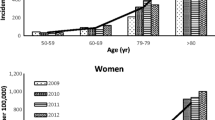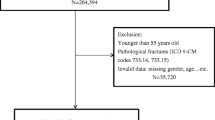Abstract
Summary
A growing elderly population is expected worldwide, and the burden of hip fractures on health care system will continue to increase. By 2035, there will be a 2.7-fold increase in the number of hip fractures in Taiwan. The study provides quantitative basis for the future distribution of medical resources.
Introduction
Hip fractures have long been recognized as a major public health concern. The study aimed to determine time trends in the incidence of hip fractures and to forecast the number of hip fractures expected in Taiwan up to 2035.
Methods
A nationwide survey was conducted using data from the Taiwan National Health Insurance Research Database from 2004 to 2011. A total of 141,397 hip fractures were identified, with a mean of 17,675 fractures/year. Annual incidences of hip fractures were calculated and tested for trends. Projections of the incidence rates of hip fractures and bed days associated with hip fractures were calculated using Poisson regression on the historical incidence rates in combination with population projections from 2012 to 2035.
Results
The incidence rates of hip fracture during 2004–2011 were 317 and 211 per 100,000 person-years among women and men, respectively. Over this 8-year period, the age-standardized incidence of hip fracture decreased by 13.4 % among women and 12.2 % among men. Despite the decline in the age-standardized incidence, the absolute number of hip fractures increased owing to the aging population. The number of hip fractures is expected to increase from 18,338 in 2010 to 50,421 in 2035—a 2.7-fold increase. The number of bed days for 2010 and 2035 was estimated at 161,248 and 501,995, respectively, representing a 3.1-fold increase.
Conclusions
The socioeconomic impact of hip fractures will be high in the near future. This study provides a quantitative basis for future policy decisions to serve this need.





Similar content being viewed by others
References
Brauer CA, Coca-Perraillon M, Cutler DM et al (2009) Incidence and mortality of hip fractures in the United States. JAMA 302:1573–1579
Melton LJ 3rd, Gabriel SE, Crowson CS et al (2003) Cost-equivalence of different osteoporotic fractures. Osteoporosis Int 14:383–388
Roberts SE, Goldacre MJ (2003) Time trends and demography of mortality after fractured neck of femur in an English population, 1968–98: database study. BMJ 327:771–775
Randell AG, Nguyen TV, Bhalerao N et al (2000) Deterioration in quality of life following hip fracture: a prospective study. Osteoporosis Int 11:460–466
Boonen S, Autier P, Barette M et al (2004) Functional outcome and quality of life following hip fracture in elderly women: a prospective controlled study. Osteoporosis Int 15:87–94
Brown CA, Starr AZ, Nunley JA (2012) Analysis of past secular trends of hip fractures and predicted number in the future 2010–2050. J Orthop Trauma 26:117–122
Dodds MK, Codd MB, Looney A et al (2009) Incidence of hip fracture in the Republic of Ireland and future projections: a population-based study. Osteoporosis Int 20:2105–2110
Holt G, Smith R, Duncan K et al (2009) Changes in population demographics and the future incidence of hip fracture. Injury 40:722–726
Kannus P, Niemi S, Parkkari J et al (1999) Hip fractures in Finland between 1970 and 1997 and predictions for the future. Lancet 353:802–805
Langley J, Samaranayaka A, Davie G et al (2011) Age, cohort and period effects on hip fracture incidence: analysis and predictions from New Zealand data 1974–2007. Osteoporosis Int 22:105–111
Papadimitropoulos EA, Coyte PC, Josse RG, Greenwood CE (1997) Current and projected rates of hip fracture in Canada. CMAJ 157:1357–1363
White SM, Griffiths R (2011) Projected incidence of proximal femoral fracture in England: a report from the NHS Hip Fracture Anaesthesia Network (HIPFAN). Injury 42:1230–1233
Burge R, Dawson-Hughes B, Solomon DH et al (2007) Incidence and economic burden of osteoporosis-related fractures in the United States, 2005–2025. J Bone Miner Res 22:465–475
Gullberg B, Johnell O, Kanis JA (1997) World-wide projections for hip fracture. Osteoporosis Int 7:407–413
Kanis JA, Oden A, McCloskey EV et al (2012) A systematic review of hip fracture incidence and probability of fracture worldwide. Osteoporosis Int 23:2239–2256
Shao CJ, Hsieh YH, Tsai CH, Lai KA (2009) A nationwide seven-year trend of hip fractures in the elderly population of Taiwan. Bone 44:125–129
Council for Economic Planning and Development (2013) Census data and population projection. http://www.cepd.gov.tw/m1.aspx?sNo=0000455. Accessed 28 Mar 2014
National Health Insurance News (2013) http://www.nhi.gov.tw/webdata/webdata.aspx?menu=17&menu_id=659&WD_ID=897&webdata_id=3584. Accessed 27 Mar 2014
Korhonen N, Niemi S, Parkkari J et al (2013) Continuous decline in incidence of hip fracture: nationwide statistics from Finland between 1970 and 2010. Osteoporosis Int 24:1599–1603
Johansson H, Clark P, Carlos F et al (2011) Increasing age- and sex-specific rates of hip fracture in Mexico: a survey of the Mexican Institute of Social Security. Osteoporosis Int 22:2359–2364
Fisher AA, O’Brien ED, Davis MW (2009) Trends in hip fracture epidemiology in Australia: possible impact of bisphosphonates and hormone replacement therapy. Bone 45:246–253
Chang KP, Center JR, Nguyen TV et al (2004) Incidence of hip and other osteoporotic fractures in elderly men and women: Dubbo Osteoporosis Epidemiology Study. J Bone Miner Res 19:532–536
Schwenkglenks M, Lippuner K, Hauselmann HJ et al (2005) A model of osteoporosis impact in Switzerland 2000–2020. Osteoporosis Int 16:659–671
Giversen IM (2006) Time trends of age-adjusted incidence rates of first hip fractures: a register-based study among older people in Viborg County, Denmark, 1987–1997. Osteoporosis Int 17:552–564
Hagino H, Furukawa K, Fujiwara S et al (2009) Recent trends in the incidence and lifetime risk of hip fracture in Tottori, Japan. Osteoporosis Int 20:543–548
Kannus P, Niemi S, Parkkari J et al (2006) Nationwide decline in incidence of hip fracture. J Bone Miner Res 21:1836–1838
Lofthus CM, Osnes EK, Falch JA et al (2001) Epidemiology of hip fractures in Oslo, Norway. Bone 29:413–418
Nymark T, Lauritsen JM, Ovesen O et al (2006) Decreasing incidence of hip fracture in the Funen County, Denmark. Acta Orthop 77:109–113
Boereboom FT, Raymakers JA, de Groot RR et al (1992) Epidemiology of hip fractures in The Netherlands: women compared with men. Osteoporosis Int 2:279–284
Kanis JA (1993) The incidence of hip fracture in Europe. Osteoporosis Int 3(Suppl 1):10–15
Lee CM, Sidhu JS, Pan KL (1993) Hip fracture incidence in Malaysia 1981–1989. Acta Orthop Scand 64:178–180
Obrant KJ, Bengner U, Johnell O et al (1989) Increasing age-adjusted risk of fragility fractures: a sign of increasing osteoporosis in successive generations? Calcif Tissue Int 44:157–167
Parkkari J, Kannus P, Niemi S et al (1994) Increasing age-adjusted incidence of hip fractures in Finland: the number and incidence of fractures in 1970–1991 and prediction for the future. Calcif Tissue Int 55:342–345
Jaglal SB, Weller I, Mamdani M et al (2005) Population trends in BMD testing, treatment, and hip and wrist fracture rates: are the hip fracture projections wrong? J Bone Miner Res 20:898–905
De Laet C, Kanis JA, Oden A et al (2005) Body mass index as a predictor of fracture risk: a meta-analysis. Osteoporosis Int 16:1330–1338
Chevalley T, Rizzoli R, Nydegger V et al (1994) Effects of calcium supplements on femoral bone mineral density and vertebral fracture rate in vitamin-D-replete elderly patients. Osteoporosis Int 4:245–252
Schurch MA, Rizzoli R, Slosman D et al (1998) Protein supplements increase serum insulin-like growth factor-I levels and attenuate proximal femur bone loss in patients with recent hip fracture. A randomized, double-blind, placebo-controlled trial. Ann Intern Med 128:801–809
Feder G, Cryer C, Donovan S et al (2000) Guidelines for the prevention of falls in people over 65. The Guidelines’ Development Group. BMJ 321:1007–1011
Holt G, Macdonald D, Fraser M et al (2006) Outcome after surgery for fracture of the hip in patients aged over 95 years. J Bone Joint Surg (Br) 88:1060–1064
Sexson SB, Lehner JT (1987) Factors affecting hip fracture mortality. J Orthop Trauma 1:298–305
United Nations (2013) World Population Ageing Report 2013
Taiwan Medical Association (2013) Doctors specialty stats. http://www.tma.tw/stats/stater.asp. Accessed 25 Jan 2014
Acknowledgments
This study received no specific funding.
The authors are grateful to Mrs Yi-Ling Liu (MHA, Research Assistant, Da Chien General Hospital, Miaoli, Taiwan) for her assistance in data management.
Conflicts of interest
None
Author information
Authors and Affiliations
Corresponding author
Rights and permissions
About this article
Cite this article
Chen, IJ., Chiang, CY.F., Li, YH. et al. Nationwide cohort study of hip fractures: time trends in the incidence rates and projections up to 2035. Osteoporos Int 26, 681–688 (2015). https://doi.org/10.1007/s00198-014-2930-z
Received:
Accepted:
Published:
Issue Date:
DOI: https://doi.org/10.1007/s00198-014-2930-z




